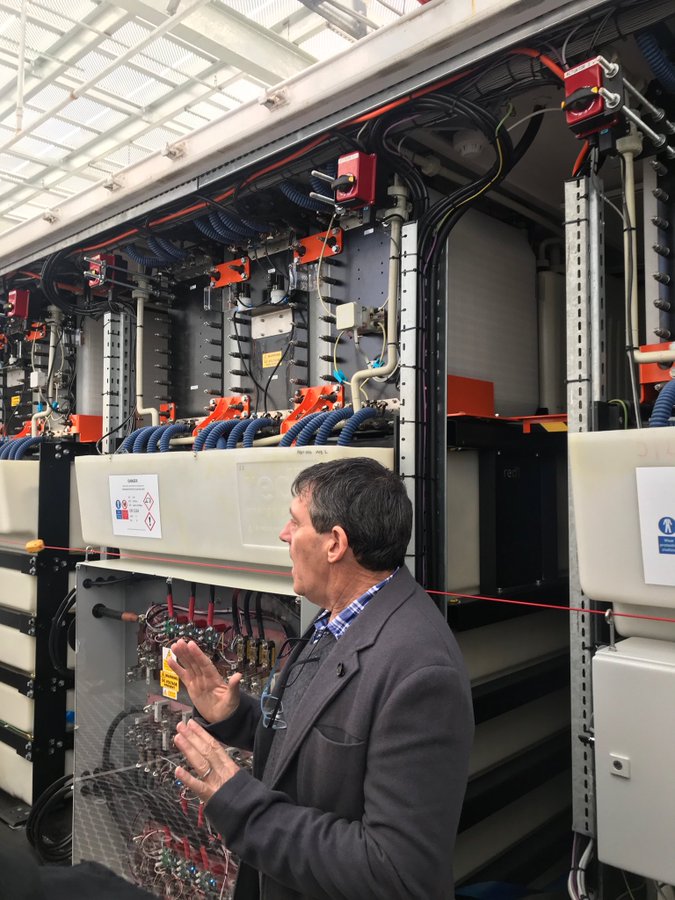The Monash Smart Energy City project, developed as part of the University’s goal to achieve zero net emissions by 2030, has reached a new milestone with the official launch of Australia’s biggest behind-the-meter battery. Started in October 2018, the microgrid development aims to cover 100% of the Clayton campus’ electricity needs with renewable energy with the help of both long- and short-duration energy storage.
The hybrid system combines a 180kW/900kWh vanadium redox flow battery system and a 120kW/120kWh C1-rated lithium-ion battery. As U.K. vanadium flow battery manufacturer RedT explained after it installed the system in 2018, the vanadium-flow “workhorse” provides around 80% of the energy and has the ability to store energy for more than four hours, while the lithium-ion batteries provide bursts of power for demand surges. The lithium-ion battery, supplied by Germany’s Tesvolt, uses Samsung cells. It can store energy for one to two hours and will be used for occasional bursts of short demand spikes.
The project will test the microgrid across the Monash University Clayton campus in Melbourne’s south east, utilizing Indra’s InGrid Advanced Grid Management IoT platform. The solution provides dynamic, proactive, distributed and smart medium- and low-voltage grid operation. Indra experts predict that by 2020, the University will be generating 7 GWh (enough to power 1,000 homes for a year), as its rooftop PV fleet continues to grow.
When completed, the $7.1 million microgrid will be operated as a grid connected smart embedded network containing a variety of distributed energy resources, including up to 1 MW of rooftop solar, 20 buildings with automated energy management systems, 1 MWh of battery storage and electric vehicle charging stations.
As part of the project, the RedT hybrid battery system will also be used to provide balancing services to the Victorian grid, earning additional revenue for the site. On top of that, the microgrid will provide an example for further research and industry engagement with renewable-based energy systems.
Hybrids in Australia
While the combination of two complementary technologies offers an attractive prospect for firming up intermittent renewable generation, there are only a few hybrid energy storage systems currently in operation across the globe. In Australia, the University of New South Wales (UNSW), the birthplace of pioneering PV technologies, is currently developing Australia’s first large-scale hybrid energy storage that will combine lithium-ion batteries and hydrogen fuel cells. The system will be installed at Risen Energy’s 121 MW Yarranlea Solar Farm in Queensland.
Ecoult, meanwhile, is an active hybrid energy storage system provider. The company was established in 2007 by the Commonwealth Scientific and Industrial Research Organisation (CSIRO) as a vehicle to develop and commercialize UltraBattery, a hybrid lead-acid battery and carbon ultracapacitor it invented. Oil and gas producer Santos is using Ecoult’s systems in a PV-powered trial to replace diesel generators for pumps that continuously deliver oil from below the ground. Early signs of success suggest that the trial will serve as a test case for deployment at thousands of oil-production sites in Australia, in addition to other offgrid applications.
This content is protected by copyright and may not be reused. If you want to cooperate with us and would like to reuse some of our content, please contact: editors@pv-magazine.com.









The ‘hybrid’ energy storage system, has the redox flow battery with a typical lithium ion storage system for fast reaction. Does this mean that redox flow batteries have the property like VRLA batteries, in that the harder one discharges the battery the more the voltage drops and so does the output power? Are there redox ion parings that can discharge like lithium ion battery technology? Why not use lithium titanate batteries, 2.3 to 2.4VDC per cell and yet can be charged and discharged almost like a super capacitor. Claims are if you treat these battery packs like typical lithium ion battery packs no more than 70% to 80% DoD, you could get 15,000 to 30,000 cycles per battery pack.
Great that Australia’s biggest behind-the-meter energy storage launched, energy storage and renewable energy needs are increasing and so the battery energy storage market is also growing globally, Battery Energy Storage System Market worth 8.54 Billion USD by 2023
Know more@ https://www.marketsandmarkets.com/Market-Reports/battery-energy-storage-system-market-112809494.html